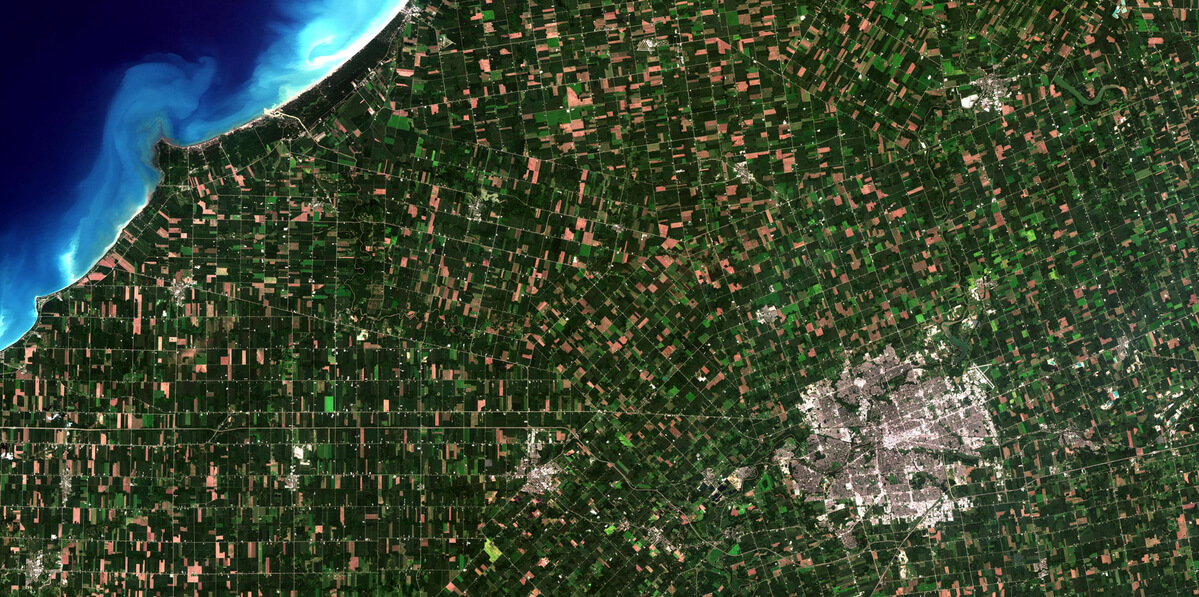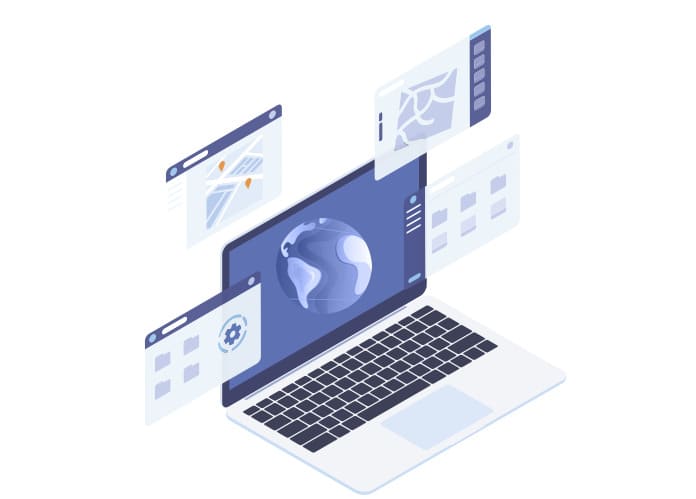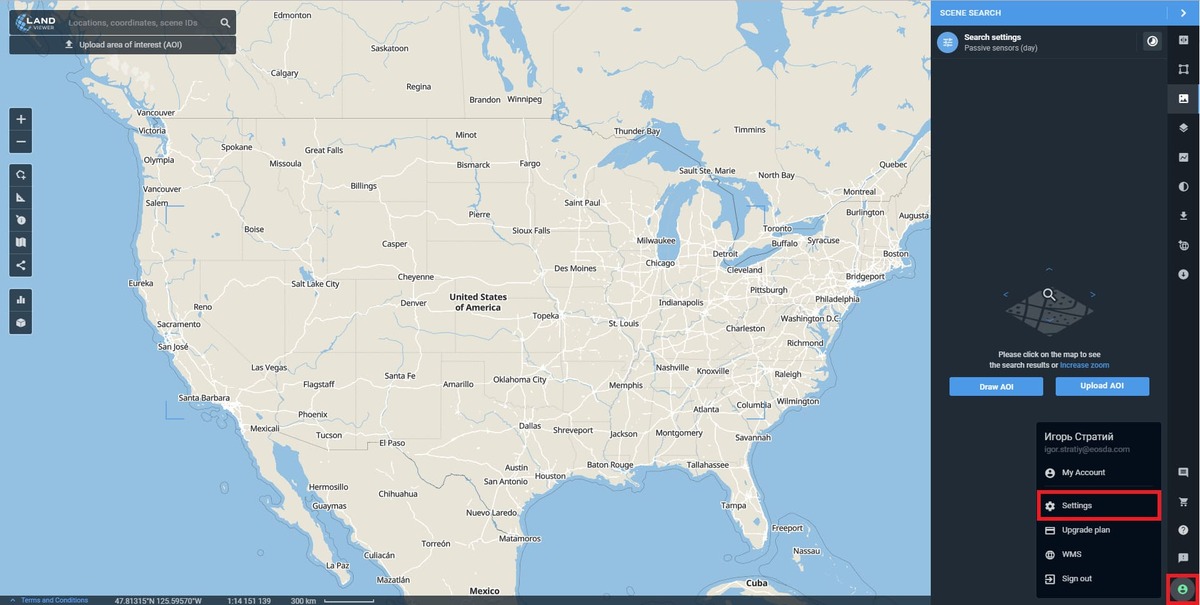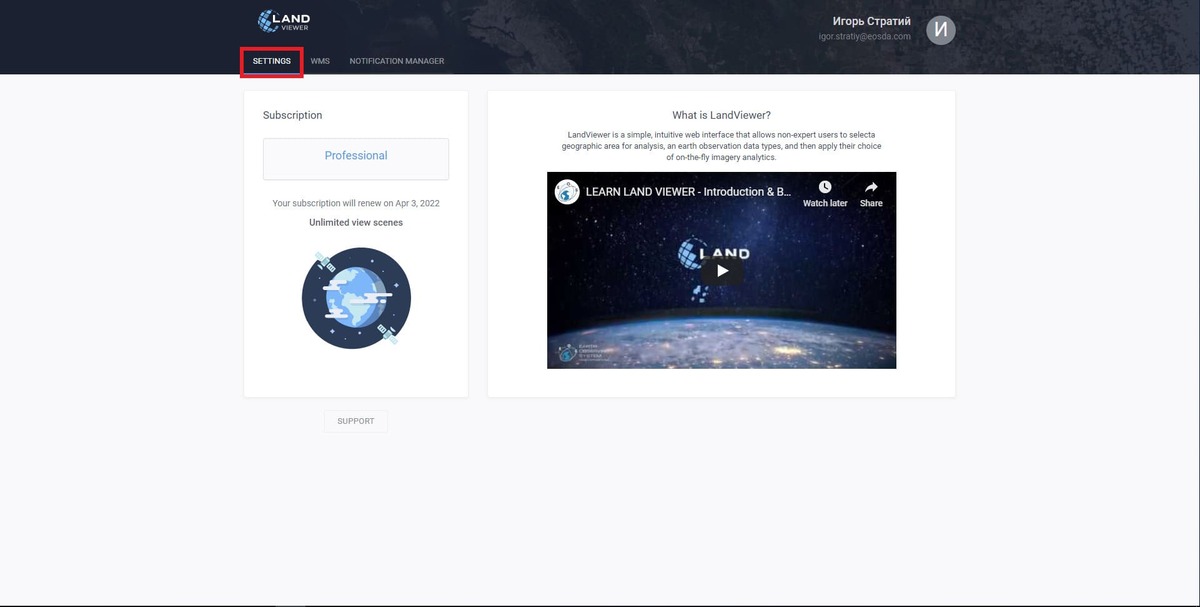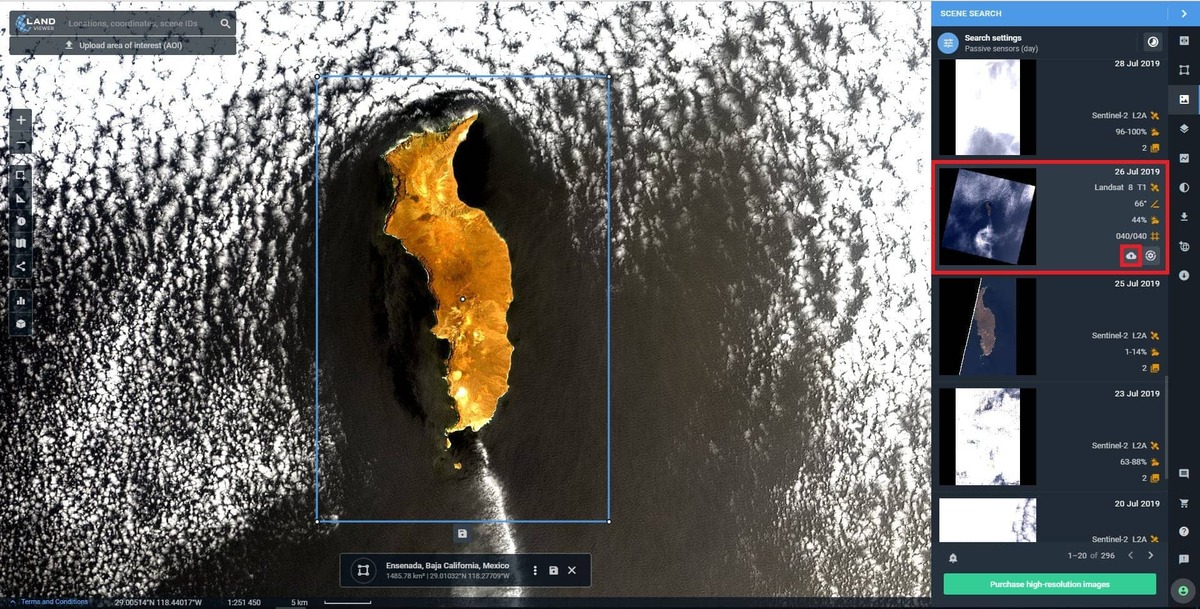Some sections of your area of interest (AOI), especially it’s true in case of a large AOI, that covers several scenes as well as AOIs (no matter how large), which are located at the junction of the scenes, remain overboard, which leads to a partial analysis and loss of valuable insights. To approach this issue, EOSDA LandViewer has introduced the new Mosaic function – an easy-to-use feature that lets you combine daily satellite images from the same sensor for a set location, apply default or custom indices on the fly, and download the results for further analytics.
To get started with the Mosaic tool, please follow these simple steps:
1. At first set (find, upload, draw) your AOI. When done, in the Filters tab select the sensor, set Cloudiness and Sun Elevation values. If your AOI is not covered with a single image, the Mosaic will be automatically created to obtain the full coverage. The Mosaic icon indicating the number of scenes in mosaic is displayed in the image preview card.

2. Once the Mosaic is chosen you can apply various band combinations. Select the required one from the Band Combinations tab and it will be immediately applied to your image.

3. There is also a possibility of using Contrast Stretching tool. You can select it from the menu by clicking Contrast stretching tab. Once it’s done hit the Edit button and manually set the required parameters. You can apply changes for previewing and save them when the needed result is achieved.

4. You can share your mosaic by clicking the Share button in the tool-box on the left side of the screen. The system offers several sharing options – link creating or sharing via such platforms as Facebook, LinkedIn or Twitter.

Choosing the creation of a link option will lead to an opening of a preview window, with an ability to select file size (small, medium or large).

5. To download the Mosaic, go to the Scene Downloading tab. The preview card will appear on the top of the downloading tab. It displays the date, the sensor, cloud coverage, the Sun elevation angle, the number of scenes in the Mosaic. Three types of downloads can be applied to Mosaic, these are – Visual, Analytics or Indices, depending on the user’s request.

- In case you select the Visual type, the resulting data will be delivered in the shape of JPEG, KMZ, GeoTIFF file, containing the merged scenes (e.g. all the scenes that fall into the AOI and don’t intersect.);
- The download result with the Analytics type will be an archive of the merged bands without metadata, for example (GeoTiff1: B02, GeoTiff2: B03, GeoTiff3: B04, GeoTiff4: B05.);
- With the Indices type, the result data for the mosaic will be presented as a TIFF file.
In the Scene Downloading menu, you can select the resolution of the image and its format. Select one of the suggested resolutions (S ~ 649×452 px 40 m/px, M ~ 1299×905 px 20 m/px, L ~ 2598×1810 px 10 m/px or XL ~ 5196×3620 px 5 m/px) that display ground sampling distance and the most suitable file format (JPEG, KMZ or GeoTIFF).

There is also an option to download by crop. To use this function you should enable the Crop image switch at the bottom of the Scene Downloading menu and stretch the bbox to set the area you want to download. In case the crop parameters are not set, all scenes are downloaded fully.

Once you select all needed settings, click the Download button at the bottom of the menu and you will see a pop-up displaying the start of the downloading. Also, please note that if you want to crop beyond the territory, covered by your AOI, the image will nevertheless be saved within the set AOI. The download limit for one file is 2 GB.
Applied fields
Agro monitoring: identify crop yields on a large scale, assess multiple fields all-in-one, no matter what territory they occupy, apply different vegetation indices and build fertilizers for all your fields at once, analyze your territories without data loss – sowing, watering, weather risks as well as farming equipment map.
Natural disasters: assessment of natural and man-made disasters impact. Fire monitoring, identification of droughts, defining of the damaged areas with the help of specific indices on a large territories. Observe floods and detect their sources no matter how far they are.
Coastal monitoring: analysis of coastal zones of long extent, monitoring of coastline changes, bathymetric analysis of water bodies as a whole through comparsion of images from different times, monitor melting of glaciers no matter how big they are, watch out for arctic rivers change.
Construction: monitoring and change detection of construction development within a large area of interest, mostly it comes in use for companies who are going to put in action ambitious projects on a large areas to keep track of which using traditional methods is impossible. This feature will be extremely useful for road designers and constructors. Pave roads guided by the latest up-to-date images composed in a convenient mosaic without any displacements or losses.
Forestry: monitoring of illegal deforestation on a large scale using mosaic approach to assess the damage of such activities.
The objective of Change Detection is to compare the spatial representation of two points in time by controlling all variances caused by differences in variables that are not of interest and to measure changes caused by differences in the variables of interest. Change detection for GIS is a process that measures how the attributes of a particular area have changed between two or more time periods, comparing two satellite images taken at different times. Change detection has been widely used to assess deforestation, urban growth, the impact of natural disasters and land cover changes etc.
To get started with the Change Detection function, please follow several simple steps:
1. Firstly set/upload/draw your area of interest (AOI). Once it’s done, in the FILTERS tab select the sensor, set Cloudiness and Sun Elevation values. After that, go to Analysis Tools menu and click Change Detection.
NB You need to select the scene to make the Change Detection active.
2. Once the first image is chosen, it appears on the map in the left side of the Comparison slider, while the right part contains the search panel to find the second image. When you get started with searching, a prompt message on how to proceed in a proper way occurs in the right menu. The Cloudiness is set up to 30% and the data source is chosen accordingly to the first image sensor by default. Use the buttons L / R to switch between the images on the slider.
3. At this step, please select the second image, dating from a different period of time to detect and assess the changes happened. Once both images appear on the map, click the Change Detection button to access the feature’s menu.
4. Choose the index you want to detect the changes for from the list in the Indices drop-down menu. To make whatever setting’s changes Click the “Back to scene search” button in the right upper menu. You can also check both images metadata and switch between the images on the map clicking the thumbnail pictures in turn. In order to select the necessary index go to Band combination drop-down menu. The scenes are displayed in “natural color”.
5. Once all the options are set, click Calculate. The outcome image is displayed over the originals ones. Once it is calculated, a slider to change the transparency of the difference layer appears on the map, and, below you can find the Change Detection Legend, displaying the index values by different colors. In our case, the resulting image shows positive changes in NDVI values.
6. Now you can either download the image in .png, .tiff or .jpeg format on your device or save it to your EOSDA Storage account.
With Time Series Analysis, you can visualize the data dynamics, constructing a spatiotemporal time series vegetation indices (VI) graph. The approach is widely employed in regional vegetation growth dynamics observation, phenological crop identification, land use change detection, etc. To use the Time Series Analysis is easy. You just need to set the AOI, time period and vegetation index. Once the graph is built, check the metric details of the selected Scene, Preview it on the map and download the result data as Excel file for further processing.
To get started with Time Series Analysis, take the following steps:
- Set the AOI (maximum processing area – 200 km2) and click the Time Series Analysis icon
- Choose the spectral index (NDVI, NDWI, NDSI) from the drop-down menu in the Time Series section on the top of the graph. Then select the sensor from the drop-down menu and time period; time intervals of (1, 3, 6, 12) months and (3, 5, 10) years are set by default. To build analytics with the selected parameters click Apply
- click Figure or Table on the right of the graph to download the result data as CSV file for further processing
- Left-click the point on the graph to check the metric details of the particular Scene, that is Source Data, Cloudiness, Mean, P10/P90, Median, sd, Min / Max
- To Preview the result, click Visualize in the top right of the image and the selected Scene shows up on the map
EOSDA LandViewer is connected to Airbus SE via API, therefore you can preview high-res satellite images, select the one that fits your AOI most and purchase it. The procedure is as follows:
- Set the AOI and select High resolution imagery (for analytics) category in the Source drop-down menu of All Filters tab. Apply the other filters
Preview the available scenes on the map and check the details. The price is given in US dollars and highlighted in green. It also provides you with the information about the area of intersection between the selected image and your AOI the final price is based on. In other words, the larger the area of intersection, the higher the price charged. Select the necessary images and click Add to cart.
Check the adding progress status, which is displayed in the bottom right of the screen. Once the process is completed, the notification In cart shows up in the image field.
Click Your Cart icon to check the order.
In the cart box specify the number of end-users in License field, tick the EULA (End-User License Agreement) box to confirm you agree to terms and click Submit.
NB We also offer a flexible discount system that depends on the number of images as well as the size of the area purchased.
The notification box shows up once your request is successfully sent. Once all the purchased details are agreed, the payment link or invoice shows up in the middle of the screen. When the payment is received, the image is distributed it to your EOSDA Storage account within three business days. At this step, you can download the purchased high-resolution satellite images directly from the EOSDA Storage.
Create a three-dimensional representation of your AOI with a powerful visualization tool – 3D Terrain Modeling. How to use it:
- set the AOI, select the Terrain layer and click the 3D Modeling icon in the toolbar on the left
- wait a few seconds until 3D Modeling is in progress
- customize your 3D Model, using (+) and (-), the mouse buttons and keyboard arrows
Zoom in to view the terrain details
To make a 3D Model of the satellite image, set the AOI, select the image and apply 3D Modeling feature
Wait a few seconds until 3D Modeling is in progress and navigate the Model according to your needs
With WMS (Web Maps Serviсе) you can integrate EOSDA LandViewer data into 3rd party tool. Using the function, browse the imagery from EOSDA LandViewer directly in your desktop or online software applications like QGIS, ArcGIS, EOSDA Vision, etc. for further processing
*To add the data to WMS you should have a client with WMS 1.3 protocol support only
To get started with WMS, take the following steps:
- Set the AOI and click add to WMS layer in the context menu

- Once it’s done, in the special WMS box set the Date, check the specifications and click Add to get a wms url link

- Copy it and use for further processing whenever you need

To check, edit and copy the list of your WMS links, stored in the section, go your Profile settings and select WMS


To view and compare two images from one or several satellites, use the Comparison slider that splits the screen into two parts. You can also apply the band combinations and spectral indices. To use it:
- set the AOI
- process the image according to your needs
- click Comparison slider in the right sidebar
- once the screen is split into 2 parts (the left part – the processed image, the right one – the base map), repeat the workflow described above.
- move the slider left and right to change the size of the parts
Another progressive functionality is designed to specify definite, averaged in definite index ranges, zones within the AOI, with clear boundaries, displaying the results of zone parameters’ calculation and the ability to export them to other software.
How it works
The tool transforms a high-resolution raster map into zones that share common index values. As a result of clustering + vectorization, you will get two new layers within the selected AOI. The first one is a raster layer containing the zones, which are highlighted with respective color and their boundaries determined by the same color. And the other one is vector layer, which contains b/w image, where each particular zone is indicated by a black color outline, and the detailed information about each zone that can be exported directly to a shapefile for further processing in other applications.
1. To get started with Clustering, you should draw your AOI using the tool-box on the left, choose the data source and select the image, covering your AOI 100%.
2. Once it’s done, click Clustering icon on the right
3. Select the Band combination from the drop-down menu, set the number of Classes (zones) and the Minimum zone area you are going to analyze. After that make step 1 and apply Show preview to display the results of raster zone calculation.
4. Make step 2 and click Calculate metrics to start vector calculation. Once the calculation is completed, the results are saved in your EOSDA Storage account by default. To download the layers on your device, click the Download button in the bottom menu.
5. To check the metrics details of the specific zone, left – click any place of the selected zone. Manage color and borders setting using Fills and Borders buttons respectively. Choose the downloading geo-format from the list available.
Applied fields
Agro monitoring: identification of high/low crop yield and affected vegetation areas, different types of vegetation areas to build fertilizers, sowing/resting, watering as well as drones’ routes and farming equipment map.
Coastal monitoring: analysis of coastal zones, coral reefs to assess and analyze water temperature, salinity, phytoplankton, hydrology, changes in coastline, bathymetry, soil moisture as well as potential threats to shores.
Forestry: identification of specific zones by vegetation density, vegetation type, monitoring of deforestation yet together with the vegetation change dynamics using time series approach.
